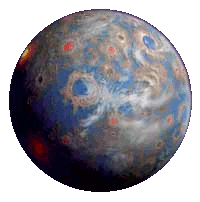Nomad Planets
March 8, 2012
Not having
television to occupy their
nights, our
ancestors would stare at the nighttime sky. The
ancient Greeks had a
significant interest in
astronomy.
Homer's Iliad and
Odyssey mention a few celestial objects, including the
Pleiades, and the
constellations Ursa Major,
Boötes and
Orion.

Homer's Iliad, Book 18, lines 483-489. In this passage, Thetis asks Hephaestus to make armor for her son, Achilles. This armor is decorated with celestial objects that include the Sun, a full Moon, and all the constellations. Mentioned by name are the Pleiades, the Hyades, Orion, and Ursa Major. (From Project Perseus).[1)]
The
English word,
planet, derives from the
Greek word
πλανητης, wanderer. To the ancients, planets were wandering
stars. Interestingly, the Greeks thought that the rising and setting
Venus were two different planets, Phosphorus and
Hesperus.
Pythagoras is said to have identified these as a single planet. Since none of his texts have survived, we must believe secondary sources for this account.
The idea of a wandering planet was taken to an extreme in the
science fiction novel,
When Worlds Collide, by Philip Wylie and Edwin Balmer. In this story, two planets, Bronson Alpha and Bronson Beta (named after their discoverer, Bronson), wandered into our
Solar System. Alpha crashes into the
Earth, but not before
spaceships from Earth reach Beta with people from Earth. Beta is fortunately habitable, and it occupies Earth's orbital slot.
The book was made into a 1951
movie,
When Worlds Collide,[2] but the interesting thing about the movie adaptation is that the rogue planets were replaced by a wandering
star and planet. The possible reason for the change is that by that time everyone knew that planets were bound to stars and would never exist in
interstellar space. Well, perhaps they do.
Gravitational microlensing, as I reported in a
recent article (Billions and Billions, January 20, 2012), has become a useful technique for planet discovery. Although
astronomers didn't think that free-floating, rogue, or nomad, planets existed, observations using gravitational microlensing suggest that they do.[3-6] A study just published suggests that there may be up to 100,000 rogue planets for every star.
About a decade ago, planets were discovered that had no obvious stellar host. Last May, a paper in
Nature reported the discovery by gravitational microlensing of about a dozen massive nomad planets. Speculation at that time was that there might be two
Jupiter-sized nomad planets per star. At that point, astronomers at the
Kavli Institute for Particle Astrophysics and Cosmology, a joint institute of
Stanford University and the
SLAC National Accelerator Laboratory, decided to investigate just how prevalent such nomad planets may be.[3-5]
Their estimate of 100,000 per star was made by a
computer simulation that took into account such parameters as the
gravitational field of the
Milky Way galaxy, how much
matter would have been available for planet formation, and how that matter would have been partitioned into planets as small as
Pluto and as large as Jupiter. The calculations showed that the discovered Jupiter-class nomads were merely the
tip of a huge iceberg of nomad planets.[3,5]

Caution is suggested by
Ray Jayawardhana, an astronomer at the University of Toronto, who was quoted in the Christian Science Monitor as saying, "...We have no evidence at all from observations yet that anything close to that number is really out there." [4] These are, after all, just the results of a computer model.
Nonetheless, there is already speculation that these planets might be warm enough to harbor bacteria that may have seeded life throughout the galaxy, somewhat along the lines of the
Panspermia Hypothesis. Their internal
radioactive heat would supply the warmth, and the occasional collision between such nomads would send bacteria-laden debris into a wide volume.[3,5]
This research, submitted for publication in the
Monthly Notices of the Royal Astronomical Society, was supported by
NASA, the
National Science Foundation and the
Royal Astronomical Society.[3]
A different study has looked at a class of planets that might be called wayward, rather than nomads. These are planets that are loosely bound to their stars and orbit at distances greater than a hundred
astronomical units from them. Many of these may be captured nomads.[6-7]
References:
- Greek text of the Iliad, Book 18, ll. 483-489, from Homer, Homeri Opera in five volumes, Oxford University Press. 1920, via Project Perseus. English translation from Homer, The Iliad with an English Translation by A.T. Murray, Ph.D. in two volumes, Harvard University Press, Cambridge, and William Heinemann, Ltd., London, 1924, via Project Perseus.
"Therein he wrought the earth, therein the heavens therein the sea, and the unwearied sun, and the moon at the full, and therein all the constellations wherewith heaven is crowned—the Pleiades, and the Hyades and the mighty Orion, and the Bear, that men call also the Wain, that circleth ever in her place, and watcheth Orion, and alone hath no part in the baths of Ocean."
- When Worlds Collide, 1951, Rudolph Maté, Director, on the Internet Movie Database.
- Andy Freeberg, "Researchers say galaxy may swarm with 'nomad planets'," Stanford University Press Release, February 23, 2012.
- Pete Spotts, "Could free-floating 'nomad' planets carry seeds of life in the universe?," Christian Science Monitor, February 24, 2012.
- Jessica Berman, "Astronomers Say Galaxy May Be Awash with Homeless Planets," Voice of America News, February 24, 2012.
- Dave Mosher, "Nomad Planets More Common Than Thought, May Orbit Black Holes," National Geographic News, February 24, 2012.
- Hagai B. Perets and M. B. N. Kouwenhoven, "On the origin of planets at very wide orbits from re-capture of free floating planets," arXiv Preprint Server, February 10, 2012.
Permanent Link to this article
Linked Keywords: Television; night; ancestor; ancient Greeks; Greek astronomy; astronomy; Homer; Iliad; Odyssey; Pleiades; constellation; Ursa Major; Boötes; Orion; Thetis; Hephaestus; Achilles; Sun; Moon; Hyades; Project Perseus; English; planet; Greek; πλανητης; star; Venus; Hesperus; Pythagoras; science fiction novel; When Worlds Collide; Solar System; Earth; spacecraft; spaceship; movie; When Worlds Collide; interstellar medium; interstellar space; gravitational microlensing; astronomer; Nature; Jupiter-sized; Kavli Institute for Particle Astrophysics and Cosmology; Stanford University; SLAC National Accelerator Laboratory; computer simulation; gravitational field; Milky Way galaxy; matter; Pluto; tip of the iceberg; NASA; JPL; Ray Jayawardhana; University of Toronto; Christian Science Monitor; bacteria; Panspermia Hypothesis; radioactive decay; radioactive; Monthly Notices of the Royal Astronomical Society; National Science Foundation; Royal Astronomical Society; astronomical unit; Internet Movie Database.